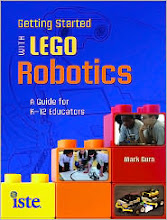Saturday, September 22, 2012
Robot Band: They need to work on the choreography!
Check out their fan site: http://www.thetrons.co.nz/
Programmed? Yes! Autonomous? No! They can't jam, can't improvise!
Devoid of personality, true - but why do humans love to imitate them?
Thursday, September 20, 2012
Tuesday, September 11, 2012
LEGO Robotics Featured at ISEA Conference (International Stem Education Association)
LEGO Robotics is featured at the upcoming ISEA Conference!
Robotics is a proven and effective way to
engage students in
hands-on science, technology,
engineering, and math learning.
Robotics is a proven and effective way to
engage students in
hands-on science, technology,
engineering, and math learning.
Can get
students excited when they
model real-life mechanisms
and solve real-world challenges,
all while building the critical-thinking
and creative problem-solving skills.
students excited when they
model real-life mechanisms
and solve real-world challenges,
all while building the critical-thinking
and creative problem-solving skills.
Sunday, September 2, 2012
Learning Adventures with Arduino
In the book Getting Started with LEGO Robotics, I describe at length the highly effective instructional approach of posing "Learning Challenges" to students who participate in the First LEGO League competition. The motivating and focusing effect of tasking students with "Real Word Challenges" as a context for them to create, build, program, and run LEGO Robots is impressive; actually it's one of the best approaches to teaching and learning I've observed during a 40 year career as an educator. The following advertisement I found in Wired Magazine (August 2012) involves The Arduino, another variety of easy to handle Robot/Processor that can work well for students (although some feel LEGO Robitics works better for newbie teachers and students... but that's a discussion for another post/another day). Getting back to the concept of Learning Challenges, though. Based on this ad (see the quote below) I think the idea has been elevated a notch or two by the authors of a soon to be released novel, which reportedly involves students in learning challenges and explains how to work with Arduino. I admire this creative approach that not only teaches STEM content in that most wonderful way, hands-on Student Robotics, but further motivates students through reading literature and involves them in Language Arts... cool idea!
" ... James and Harold have written a fictional story of two students trapped in a damaged space station. The reader of the book uses an actual Arduino, and a variety of components that can be found at RadioShack, to simulate the various challenges the kids ace on the space station. The novel teaches children how to build circuits and program. In Arduino Adventures: Escape from Gemini Station, James and Harold provide eight challenges for kids using the Arduino. The book provides a fun experience that puts the reader in the story and teches them along the way..."
RadioShack has put up a website with more information on this type of application for the Arduion: http://radioshackdiy.com/project-gallery/tough-arduino I love the way they invite user to submit their own project to its online Project Gallery
Here's a taste of what Arduino could be for school age students:
" ... James and Harold have written a fictional story of two students trapped in a damaged space station. The reader of the book uses an actual Arduino, and a variety of components that can be found at RadioShack, to simulate the various challenges the kids ace on the space station. The novel teaches children how to build circuits and program. In Arduino Adventures: Escape from Gemini Station, James and Harold provide eight challenges for kids using the Arduino. The book provides a fun experience that puts the reader in the story and teches them along the way..."
RadioShack has put up a website with more information on this type of application for the Arduion: http://radioshackdiy.com/project-gallery/tough-arduino I love the way they invite user to submit their own project to its online Project Gallery
Here's a taste of what Arduino could be for school age students:
Strawberry Picking Robot
See article, too:
"Strawberry-picking robot knows when they're ripe
Japan prepares to unleash a strawberry-harvesting robot on the world.
Strawberry fields will forever be changed by robots that can automatically identify and pick ripe berries, according to Japanese researchers.
Developed by the minds at an organization aptly abbreviated IAM-BRAIN (that's the Institute of Agricultural Machinery's Bio-oriented Technology Research Advancement Institution), the machines can harvest more than 60 percent of a strawberry crop.
The robot targets berries that are at least 80 percent red.
The robots can also pick strawberries at night. There's more video of the machine at work here, on BRAIN's Japanese page.
The berry bot has a stereo camera system that images the strawberries in 3D. Image-processing algorithms gauge their ripeness, and if a berry is at least 80 percent red, the machine neatly snips it at the stem and deposits it in a bin.
Read the full article at its source:
http://news.cnet.com/8301-17938_105-20025402-1.html
Subscribe to:
Posts (Atom)




